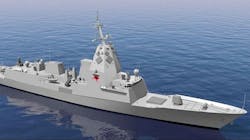Designing naval surface warships for modern anti-submarine warfare (ASW) with networked sensors
WASHINGTON – The Australian government is weighing up its options when it comes to the anti-submarine warfare (ASW) capability requirements for the forthcoming decision on Project SEA 5000—the multi-billion dollar future frigate project. The Maritime Executive reports. Continue reading original article
The Military & Aerospace Electronics take:
18 Jan. 2019 -- The proliferation of submarines in the Indo-Pacific certainly warrants close attention being paid to this decision. For starters, we need a clear understanding that ASW is about much more than just what can be expected from only one of many surface warships, no matter how sophisticated the fit-out. But who understands this esoteric field?
The one-on-one hunter–killer scenario we sometimes think of from World War II or early in the Cold War is no longer what can be expected. Now, submarines are even harder to detect and, as a result, the World War II concept of a single ship hunting a submarine is of limited utility. With only on-board sensors available to conduct detection work, the submarine would always have an advantage.
Building on evolved capabilities, ASW today involves coordinating a suite of networked sensors that involve sonar and electromagnetic sensors aloft, on the surface, and underwater to detect, track, deter, and potentially attack hostile submarines.
Related: Navy asks CCC to provide important components for sonar transducer aboard surface warships
Related: Navy orders seven TB-37 surface ship sonar systems from Lockheed Martin to hunt submarines
John Keller, chief editor
Military & Aerospace Electronics
Ready to make a purchase? Search the Military & Aerospace Electronics Buyer's Guide for companies, new products, press releases, and videos

